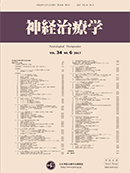Volume 33, Issue 1
Displaying 1-16 of 16 articles from this issue
- |<
- <
- 1
- >
- >|
-
2016Volume 33Issue 1 Pages 1
Published: 2016
Released on J-STAGE: May 20, 2016
Download PDF (151K) -
2016Volume 33Issue 1 Pages 2-4
Published: 2016
Released on J-STAGE: May 20, 2016
Download PDF (451K)
-
2016Volume 33Issue 1 Pages 5-6
Published: 2016
Released on J-STAGE: May 20, 2016
Download PDF (270K)
-
2016Volume 33Issue 1 Pages 7-8
Published: 2016
Released on J-STAGE: May 20, 2016
Download PDF (309K) -
2016Volume 33Issue 1 Pages 9-18
Published: 2016
Released on J-STAGE: May 20, 2016
Download PDF (621K) -
2016Volume 33Issue 1 Pages 19-26
Published: 2016
Released on J-STAGE: May 20, 2016
Download PDF (988K) -
2016Volume 33Issue 1 Pages 27-31
Published: 2016
Released on J-STAGE: May 20, 2016
Download PDF (416K) -
2016Volume 33Issue 1 Pages 32-39
Published: 2016
Released on J-STAGE: May 20, 2016
Download PDF (4147K) -
2016Volume 33Issue 1 Pages 40-45
Published: 2016
Released on J-STAGE: May 20, 2016
Download PDF (1033K)
-
2016Volume 33Issue 1 Pages 46-52
Published: 2016
Released on J-STAGE: May 20, 2016
Download PDF (1307K) -
2016Volume 33Issue 1 Pages 53-56
Published: 2016
Released on J-STAGE: May 20, 2016
Download PDF (475K)
-
2016Volume 33Issue 1 Pages 57-59
Published: 2016
Released on J-STAGE: May 20, 2016
Download PDF (2715K)
-
2016Volume 33Issue 1 Pages 60-63
Published: 2016
Released on J-STAGE: May 20, 2016
Download PDF (313K) -
2016Volume 33Issue 1 Pages 65
Published: 2016
Released on J-STAGE: May 20, 2016
Download PDF (251K) -
2016Volume 33Issue 1 Pages 66
Published: 2016
Released on J-STAGE: May 20, 2016
Download PDF (242K) -
2016Volume 33Issue 1 Pages I1
Published: 2016
Released on J-STAGE: May 20, 2016
Download PDF (102K)
- |<
- <
- 1
- >
- >|
